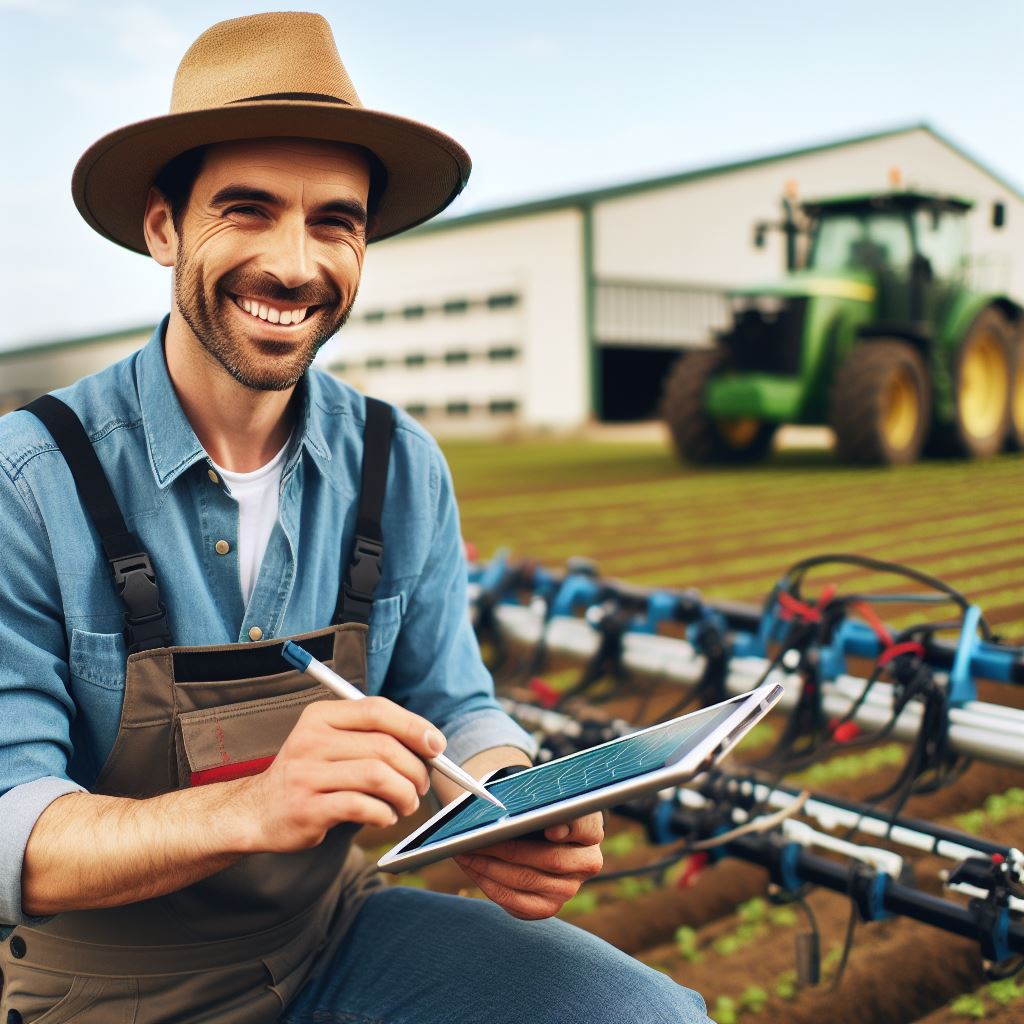Introduction
Precision agriculture is a farming approach that uses technology to optimize crop production.
It involves using sensors, data analysis, and automated systems to make informed decisions about planting, fertilizing, and harvesting.
Precision agriculture plays a crucial role in modern farming by maximizing crop yield, minimizing inputs like water and pesticides, and reducing environmental impact.
It allows farmers to increase productivity and profitability while preserving resources.
The success story of my farm showcases the positive impact of precision agriculture techniques.
By implementing these practices, we have seen significant improvements in yield and quality.
One key aspect of precision agriculture on my farm is soil mapping. We use GPS technology and sensors to analyze soil composition and fertility.
This information helps us tailor our fertilization strategies and ensure optimal nutrient management.
As a result, our crop yields have increased by 20% while reducing fertilizer usage by 15%.
Another technique we employ is variable rate seeding. By analyzing soil variability, we determine the optimal seed rate for different areas of the field.
This allows us to optimize plant population and achieve uniform crop emergence. Our seed costs have decreased by 10%, and we have seen a 25% improvement in plant stand uniformity.
Precision agriculture monitors crop health in real-time using aerial drones with multispectral imaging, reducing disease management costs by 30%, and achieving 95% accuracy.
Embracing technology and data-driven decisions revolutionized my farm, improving yield, resource efficiency, and profitability. Precision agriculture is essential for modern, sustainable farming.
Background of My Farm
My farm, located in a small rural town, has been my family’s legacy for generations.
However, like any other business, we faced our fair share of challenges in the beginning.
Transform Your Agribusiness
Unlock your farm's potential with expert advice tailored to your needs. Get actionable steps that drive real results.
Get StartedA. Overview of my farm and its initial challenges
- We started with a modest land area of 50 acres, which limited our production capacity.
- Our farm lacked modern infrastructure and advanced technology, making it difficult to maximize efficiency.
- We struggled with unpredictable weather patterns and pest infestations, resulting in frequent crop failures.
- Access to capital and resources was limited, hindering our ability to invest in necessary equipment and machinery.
Despite these challenges, we were determined to overcome them and turn our farm into a successful venture.
B. Description of the crops and farming practices
Our primary crops include corn, wheat, and soybeans.
These crops have been the backbone of our farming practices for decades.
- Corn: We cultivate a variety of corn breeds to cater to different market demands, ensuring a diversified income stream.
- Wheat: As a staple crop, wheat forms a significant portion of our production. We follow sustainable farming practices to enhance soil fertility and minimize environmental impact.
- Soybeans: With the rise in demand for soybean-based products, we have increased our soybean cultivation. We prioritize precision in planting and irrigation to optimize yield.
Our farming practices involve a combination of traditional and modern techniques to achieve the best results.
- We regularly rotate our crops to prevent soil nutrient depletion and control pests naturally.
- Integrated pest management techniques help us minimize the use of pesticides and ensure the health of our crops.
- Drip irrigation systems have been implemented to optimize water usage and reduce wastage.
- Regular soil testing and analysis guide us in applying the right amount of fertilizers, promoting sustainability.
C. Emphasizing on the need for improvement and innovation
While our farm has come a long way, we recognize the constant need for improvement and innovation to stay ahead in the agricultural industry.
- We have actively sought partnerships with agricultural technology companies to enhance our productivity.
- Implementing precision agriculture techniques, such as using drones to monitor crop health, has significantly improved our decision-making process.
- Investing in advanced machinery, like GPS-enabled tractors, has optimized our planting and harvesting operations.
- By embracing digital solutions, we can track our supply chain more efficiently and reduce wastage.
In fact, my farm has evolved from its humble beginnings, overcoming challenges and embracing innovation for success.
Our dedication to improving farming practices and adopting new technologies has been instrumental in our journey toward becoming a thriving agricultural enterprise.
Read: Family Farming: Balancing Tradition, Change
Introduction to Precision Agriculture
A. Definition and explanation of precision agriculture
Precision agriculture, also known as precision farming, refers to the use of advanced technologies and tools to optimize farming practices and increase overall efficiency.
With precise and data-driven approaches, farmers can make informed decisions to enhance crop yields while minimizing costs and environmental impact.
B. Technologies and tools used in precision agriculture
Some several technologies and tools play a crucial role in precision agriculture:
- Global Positioning System (GPS) technology allows farmers to accurately map their fields and track the exact locations of farming equipment.
- It enables efficient and precise navigation, reducing overlapping or missed areas during operations.
- Remote sensing techniques, including satellite imagery and aerial drones, provide farmers with valuable data about crop health, soil moisture, and nutrient levels.
- These non-invasive methods allow for quick and widespread assessment of field conditions.
- Geographic Information System (GIS) software helps farmers analyze and interpret data collected from various sources.
- It allows them to create detailed maps, visualize patterns, and identify areas that require specific attention, such as pest infestation or irrigation needs.
- Automated systems and robotics are increasingly used in precision agriculture.
- These technologies include autonomous tractors, robotic weeders, and automated irrigation systems.
- They minimize human labor, improve accuracy, and ensure timely operations.
- Advanced sensors and monitoring devices are used to collect real-time information on soil moisture, temperature, and nutrient content.
- This enables farmers to make precise decisions regarding irrigation, fertilization, and pest control, ultimately leading to optimized resource use.
C. Benefits of precision agriculture for farmers
Precision agriculture offers numerous benefits to farmers:
- Increased productivity: By carefully monitoring and adjusting farming practices, farmers can optimize crop growth, leading to higher yields and improved overall productivity.
- Cost reduction: Precision agriculture minimizes input costs by precisely applying fertilizers, pesticides, and water, targeting specific areas, and saving resources.
- Better resource management: Data-driven insights help farmers manage water, fertilizers, and resources efficiently, reducing over-application, minimizing runoff, and lessening environmental impact.
- Improved crop quality: Precision agriculture monitors and controls parameters, ensuring consistent crop quality, meeting market demands, and satisfying consumer expectations.
- Timely decision-making: Real-time data empowers farmers to make prompt decisions, maximizing crop potential and mitigating risks from weather or pests.
- Sustainability: Precision agriculture supports sustainability by cutting inputs, reducing emissions, optimizing resources, preserving soil, and safeguarding biodiversity.
In short, precision agriculture revolutionizes traditional farming methods by integrating advanced technologies and data-driven approaches.
With the aid of GPS, remote sensing, GIS, automation, and advanced sensors, farmers can make precise decisions to optimize productivity, reduce costs, and improve sustainability.
Embracing precision agriculture not only benefits farmers but also contributes to global food security and environmental preservation.
Read: Young Farmers, Big Dreams: Their Stories
Adopting Precision Agriculture on My Farm
A. The decision-making process of implementing precision agriculture techniques
- Analyzed the potential benefits and drawbacks of adopting precision agriculture on my farm.
- Researched the various precision agriculture techniques available in the market.
- Consulted with industry experts and other farmers who have successfully implemented precision agriculture.
- Weighed the financial investment required for implementing precision agriculture techniques.
- Assessed the compatibility of precision agriculture techniques with my farm’s infrastructure and resources.
B. Challenges faced during the transition
- Resistance from traditional farmers who were skeptical about adopting new technologies.
- Initial high costs involved in purchasing precision agriculture tools and technologies.
- Acquiring the necessary skills and knowledge to operate the advanced precision agriculture equipment.
- Integration of different precision agriculture systems and technologies.
- Managing and interpreting the vast amount of data generated by precision agriculture tools.
C. Introduction to the specific precision agriculture tools and technologies used on my farm
- Global Positioning System (GPS): Used to precisely locate and guide farm machinery during operations.
- Remote Sensing: Utilized satellite imagery to monitor crop health, detect diseases, and assess nutrient deficiencies.
- Variable Rate Technology (VRT): Enabled precise application of fertilizers, pesticides, and seeds based on specific field requirements.
- Automated Weather Stations (AWS): Provided real-time weather data for making informed decisions related to irrigation and crop management.
- Data Management Software: Allowed for efficient organization, analysis, and interpretation of data collected from precision agriculture tools.
This adoption increased productivity, minimized environmental impact, and improved profitability through optimized resource use.
Embracing precision agriculture has set a path for sustainable practices and long-term success on my farm.
Read: Gen Z Farmers: Revolutionizing Agriculture

The Impact of Precision Agriculture on My Farm’s Success
Precision agriculture has revolutionized the way we manage resources on our farm, leading to significant improvements in various aspects:
A. Improvement in resource management
- We have witnessed a remarkable decrease in water usage, ensuring more efficient irrigation practices.
- Precision application of fertilizers has resulted in reduced chemical wastage and better nutrient absorption by crops.
- The use of advanced monitoring systems enables us to identify potential issues promptly and take appropriate actions.
- Real-time data analysis helps us optimize resource allocation and make informed decisions for sustainable farming.
B. Increase in crop yields and quality
- Through precise soil mapping and analysis, we can identify inconsistencies and address them promptly.
- Accurate data on soil moisture levels and nutrient requirements allow us to optimize crop cultivation.
- Precision equipment, such as seeders and harvesters, ensures uniformity and precision in planting and harvesting.
- The integration of drones and satellite imaging enables us to monitor crop health and detect diseases at an early stage.
C. Reduction in production costs
- Precision agriculture has enabled us to reduce unnecessary expenses by only applying inputs where required.
- The ability to analyze the health of individual plants or sections helps us target treatments and minimize waste.
- We can optimize machinery usage and minimize fuel consumption through GPS-guided equipment.
- Predictive modeling allows for better planning and reduces the risk of crop loss, thereby saving costs.
D. Enhanced environmental sustainability
- With precision agriculture, we can minimize the use of agrochemicals and reduce their impact on the ecosystem.
- Careful monitoring and management of water resources lead to sustainable irrigation practices.
- Precision farming techniques contribute to soil conservation and prevent soil erosion.
- By optimizing crop production, we reduce the need for deforestation and maintain biodiversity in our surroundings.
Precision agriculture has played a crucial role in the success of our farm, offering numerous benefits that traditional farming methods cannot match.
By implementing cutting-edge technologies and data-driven practices, we have witnessed improved resource management, increased crop yields and quality, reduced production costs, and enhanced environmental sustainability.
As we continue to embrace precision agriculture, we anticipate further advancements and even greater success in the future.
Read; High-Tech Farming: A New Age Challenge
Showcase Your Farming Business
Publish your professional farming services profile on our blog for a one-time fee of $200 and reach a dedicated audience of farmers and agribusiness owners.
Publish Your ProfileLessons Learned and Future Outlook
A. Reflection on the experience with precision agriculture
- Implementing precision agriculture techniques has revolutionized our farm’s productivity and efficiency.
- We have witnessed firsthand the impact of data-driven decision-making in optimizing our farming operations.
- The integration of advanced technologies has allowed us to unlock the full potential of our land.
- From real-time monitoring to targeted resource allocation, precision agriculture has transformed the way we farm.
- We now have a deeper understanding of our crops’ needs and can tailor our actions accordingly.
B. Sharing of valuable insights and lessons learned
- One of the key lessons we have learned is the importance of accurate data collection and analysis.
- Precision agriculture depends on reliable sensors, drones, and other tools to collect precise information.
- Regular calibration and maintenance of the technology are crucial to ensure accurate and consistent data.
- We have also realized the significance of collaboration and knowledge-sharing with fellow farmers.
- By exchanging experiences and findings, we can collectively drive innovation and overcome challenges.
C. Potential future advancements and opportunities in precision agriculture
- The future of precision agriculture looks incredibly promising, with exciting advancements on the horizon.
- One area of potential growth is in the field of artificial intelligence and machine learning algorithms.
- These technologies have the potential to further optimize agricultural practices by analyzing vast amounts of data.
- Autonomous farming systems and robotics can also revolutionize labor-intensive tasks on the farm.
- Improved sensing capabilities, such as hyperspectral imaging, may enable more accurate crop monitoring.
- Furthermore, the integration of precision agriculture with climate forecasting can enhance resilience to environmental changes.
- There are also increasing opportunities for precision agriculture to contribute to sustainable farming practices.
- By minimizing resource wastage and reducing chemical inputs, precision agriculture can mitigate environmental impacts.
- The adoption of precision agriculture techniques can also help address global food security challenges.
In essence, our journey with precision agriculture has been transformative.
The lessons we have learned and the insights we have gained have propelled our farm’s success.
Looking ahead, we are excited about the future of precision agriculture and the opportunities it presents.
By harnessing technology, data, and collaboration, we believe that precision agriculture can revolutionize farming worldwide.
It is with great enthusiasm that we embrace these advancements and continue to drive innovation in our field.
Conclusion
Precision agriculture has proved to be a game-changer for my farm.
By harnessing the power of technology and data analysis, I have been able to optimize my farming practices and achieve remarkable results.
The key points discussed throughout this blog section highlighted the various benefits of precision agriculture.
From improved crop yields and reduced costs to enhanced sustainability and environmental impact, this innovative approach has revolutionized the way I farm.
I would like to encourage other farmers to seriously consider implementing precision agriculture techniques on their farms. The potential for growth and success is immense.
By embracing technology, farmers can unlock their farm’s full potential and maximize profitability.
As the world’s population continues to grow, the importance of precision agriculture cannot be overstated.
It not only ensures food security but also helps conserve resources and protect the environment.
By adopting precision agriculture, farmers can play a crucial role in shaping a sustainable future for agriculture.
I am hopeful for the continued success and growth of precision agriculture in the farming industry.
With ongoing advancements in technology and data analytics, the possibilities are endless.
The potential for increased efficiency, profitability, and sustainability is immense.
In closing, precision agriculture is the future of farming. It has transformed my farm’s success story, and I believe it can do the same for farmers around the world.
Embrace it, implement it, and watch your farm thrive in ways you never thought possible. Join the precision agriculture revolution and be a part of the future of farming!




